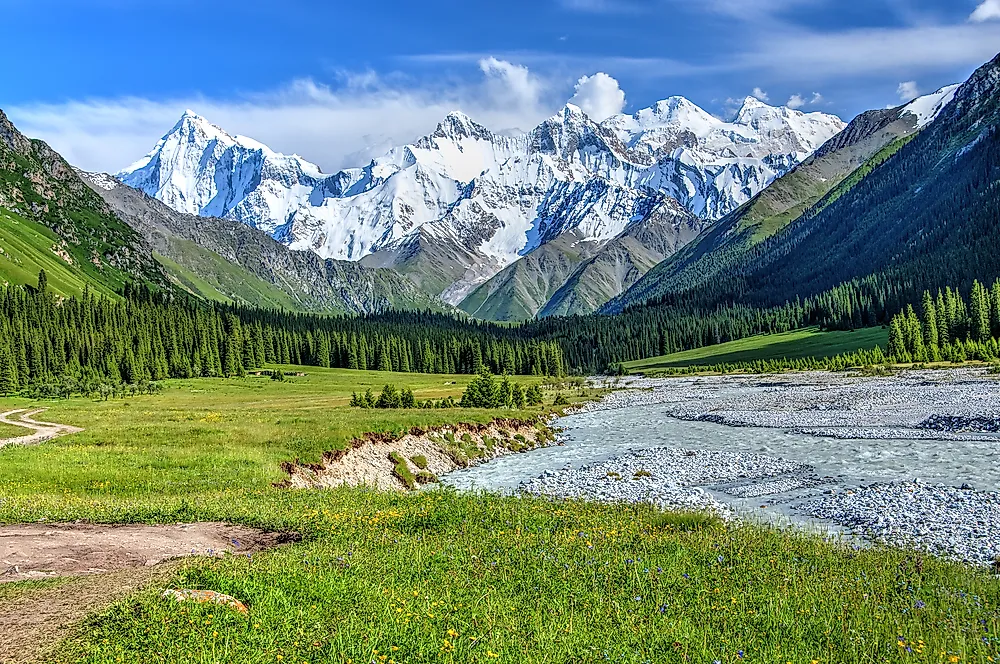The Snow Leopard Challenge: Conquering Central Asia’s Giants
The Snow Leopard (Снежный барс – Snezhnyy Bars) is one of the most prestigious achievements in mountaineering, awarded to climbers who summit all five 7,000-meter peaks of the former Soviet Union, located in the Pamir and Tien Shan ranges. Completing this challenge requires not only exceptional technical skill and endurance but also mastery over the harsh and remote landscapes of Central Asia.

Table of contents
History of the Snow Leopard Challenge
History of the Snow Leopard Challenge
Soviet mountaineers first explored these giant peaks in the 1930s, with Vitaly Abalakov completing all five as early as 1934. The formal title “Snow Leopard of the USSR” was instituted in 1961 by the USSR Sports Committee. To earn it, climbers had to summit all five peaks without supplemental oxygen.
The award symbolized the pinnacle of Soviet-era mountaineering, combining extreme technical difficulty with logistical and political challenges. After 1991, the award continued under the federations of Russia, Kyrgyzstan, and Kazakhstan, remaining a coveted goal for elite climbers worldwide.
The Five Peaks
Peak Lenin (Abu Ali ibn Sina) – 7,134 m
Straddling the Kyrgyzstan – Tajikistan border in the Trans-Alay Range of the Pamirs, Lenin is often treated as the “entry” 7,000er thanks to a non-technical but seriously high and crevassed standard line via the North Face/Razdelnaya route, typically staged from Achik-Tash Base Camp (Osh side). Despite its reputation, weather can be vicious and the mountain has a tragic history – most notably the 1990 avalanche that killed 43 climbers. Normal season runs July – August; expect lengthy glacier travel, serac exposure, and winds that routinely shut down summit bids.
Peak Korzhenevskaya (Peak Ozodi) – 7,105 m
A striking pyramid in Tajikistan’s Academy of Sciences Range, Korzhenevskaya (renamed Peak Ozodi in 2020) rises above the Fortambek and Valtera glaciers and is commonly accessed from Moskvina Glade, which many teams share with Ismoil Somoni expeditions. The classic route is a long snow and ice climb on broad ridges with objective hazards (avalanches, crevasses) and significant exposure to weather. First climbed in 1953 by an eight-person Leningrad team; later milestones include the first all-women ascent (1972) and the first winter ascent (1986).
Peak Communism (Ismoil Somoni) – 7,495 m
The highest summit of Tajikistan and of the former USSR is a vast alpine fortress of ridges, hanging seracs, and corniced plateaus. Most teams use Moskvina Glade Base Camp and climb the Borodkin Ridge/Spur, a committing, high-altitude route with mixed rock/ice and big exposure – more about endurance and judgment than any single technical crux. First ascent: 3 September 1933 by Yevgeniy Abalakov; the peak bore the names Stalin (1930s), then Communism (1962), before adopting Ismoil Somoni in 1998.
Khan Tengri – 7,010 m (6,995 m rock; 7,010 m with icecap)
The “Lord of the Spirits” is a near-perfect marble pyramid at the Kazakhstan-Kyrgyzstan-China tripoint. Although the lowest of the five, it’s notably technical: long sections of mixed ground, steep snow/ice, and exposed ridges (commonly the South-West Ridge from the south or West Ridge via West Col) demand solid AD+/D-level competence, efficient movement, and comfort on fixed lines. First ascent was in 1931 by a Soviet team led by Mikhail Pogrebetsky. Its accepted mountaineering elevation includes the permanent icecap, meeting Snow Leopard criteria.
Peak Pobeda (Jengish Chokusu / Victory Peak) – 7,439 m
Crowning the border of Kyrgyzstan and China, Peak Pobeda stands as the northernmost 7,000 m summit in the world and arguably the most perilous of the Snow Leopard range. Its location in the Kakshaal-Too subrange of the Tien Shan gives it a grim reputation – subject to savage jet-stream winds, sudden temperature plunges, and brutal storms that can stall teams for days. Climbers on its West Ridge must traverse lengthy ridgelines above 7,000 m, where retreat is nearly impossible and the line between summit and survival is razor-thin. Some veteran mountaineers even argue that, psychologically and logistically, it’s harder than K2. Over the years, Pobeda has witnessed over 80 climbing fatalities, and to this day, no body has ever been brought down from its summit ridge, a stark testament to both its remoteness and lethal terrain.
In August 2025, the fatal reality of Pobeda was tragically underscored by the story of Natalia Nagovitsyna, a seasoned Russian mountaineer who had already summited four of the five Snow Leopard peaks. During descent from the summit, she slipped and broke her leg around 7,150 m, leaving her stranded at near-freezing temperatures in a torn tent. Despite repeated rescue attempts, conditions deteriorated and rescue efforts were ultimately abandoned. Thermal drone scans days later showed no signs of life, and Natalia was officially declared missing and presumed dead. Her ordeal is a painful reminder that on Peak Pobeda, even highly skilled, resilient climbers face overwhelming and often insurmountable natural forces.

The Award and Its Prestige
Recipients receive a Snow Leopard badge, often featuring a white leopard on a blue background. Modern mountaineering federations require documented proof for each summit. Fewer than hundreds of climbers have earned it, reflecting its extreme difficulty.
Modern Challenges
Today, logistics have improved, yet the peaks remain remote and dangerous. Most climbers attempt them in this order: Peak Lenin (acclimatization), Peak Korzhenevskaya, Khan Tengri (technical), Peak Communism (high-altitude test), and Peak Pobeda (final challenge). Some elite alpinists pursue a “Full House,” adding Peak Revolution (6,973 m). The Snow Leopard challenge is more than climbing – it’s a journey through the most breathtaking landscapes of Central Asia, a test of human spirit, and a link to the golden age of Soviet mountaineering.
